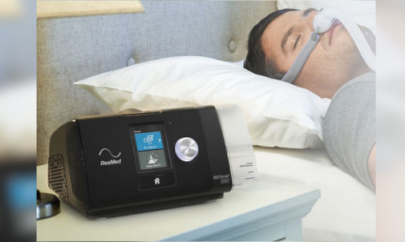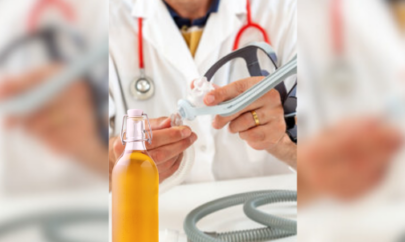
Managing Shortness of Breath When You Have Sleep Apnea
Shortness of breath is to be expected following exercise or a similar physical exertion. However, an unexpected shortness of breath can be a scary and unsettling experience.
When you have obstructive sleep apnea, you will experience this struggle to breathe while you sleep – and wake gasping for air.
Paroxysmal Nocturnal Dyspnea
A shortness of breath while you sleep is termed paroxysmal nocturnal dyspnea (PND). Someone with PND can experience breathing difficulties within a couple of hours of falling asleep.
This involves waking up gasping for breath. Sitting up or getting out of bed tends to lead to breathing improving and normalizing. This is because PND is often a symptom of an underlying cardiac or respiratory condition that results in a build-up of fluid in the lungs when sleeping.
Examples of underlying health conditions that may cause PND include:
- heart failure
- chronic obstructive pulmonary disorder (COPD)
- pneumonia
- asthma
- pulmonary edema
Another condition that increases the risk of PND is sleep apnea.
Shortness of Breath in Sleep Apnea
Obstructive sleep apnea is the most common form of sleep apnea. The sleep disorder results from a collapse or partial blockage of the airways caused by the relaxation of the throat muscles.
The breathing difficulties resulting from narrower airways see a drop in oxygen levels, prompting the brain to wake the body for air.
Similar to PND, people with obstructive sleep apnea can wake gasping for air. However, these arousals from sleep can be very brief and may occur over 30 times every hour for those with a severe degree of obstructive sleep apnea.
Symptoms of obstructive sleep apnea include:
- frequent awakenings for air
- snoring
- daytime drowsiness
- morning headaches
- dry throat
- poor concentration
- irritability
- mood swings
Without diagnosis and treatment, the resulting sleep deprivation and daytime drowsiness places you at an increased risk of falling asleep during the day. This in turn increases the risk of traffic accidents and accidents in the workplace.
Managing Shortness of Breath and Sleep Apnea
Without diagnosis, sleep apnea also increases the risk of serious health conditions. As with PND, one of these health risks is heart failure. The sleep disorder also increases the risk of stroke, high blood pressure and diabetes.
If you regularly find yourself short of breath, it is usually a sign of an underlying health condition like sleep apnea. Treating the underlying condition may therefore help regulate your breathing. In the case of obstructive sleep apnea, the treatment will depend on the severity of the disorder.
A sleep study is used to diagnose obstructive sleep apnea and determine whether you have a mild, moderate, or severe degree of the disorder. If mild, lifestyle changes including an improved diet and exercise may be recommended to help lose weight.
Obesity is one of the primary risk factors for the disorder. By losing weight you can reduce the amount of muscle tissue in the throat that may block the airways when relaxed during sleep.
Positive Airway Pressure Therapy
Positive airway pressure (CPAP) is a leading treatment for moderate to severe obstructive sleep apnea. PAP involves a device that delivers pressurized air through a mask worn as you sleep.
The air helps keep the airways clear of any obstruction, preventing the breathing difficulties that cause the brain to wake the body for air multiple times every hour of the night.
PAP can take a little adjusting to and not everyone finds they can tolerate the pressurized air. An alternative treatment involves an oral appliance similar to a mouthguard. This works by pushing the lower jaw forward to help maintain a free flow of air to the lungs.
Sleep apnea is treatable. By removing the symptoms of the disorder you can return to nights of undisturbed sleep and reduce the risk of the serious health issues linked to the condition. If the disorder is a contributing underlying factor for your nighttime shortness of breath, treatment could also stabilize your breathing.
Developing Good Sleep Hygiene
As well as leading a healthier lifestyle, developing a good sleep hygiene routine will help you manage PND better when you have sleep apnea. Optimizing the conditions to help you fall and stay asleep can benefit both conditions.
The following are 5 Tips for improving your sleep hygiene.
- Develop a sleep schedule where you go to sleep at the same time each night and get up at the same time each day. This consistency of schedule will regulate your internal body clock and should make falling asleep easier.
- Ensure your bedroom is geared to sleep. A dark, quiet bedroom with an ambient temperature encourages sleep. Switch off any screens well before bedtime and remove blue light-emitting screens that could disrupt sleep.
- Seek advice on quitting smoking and alcohol. Tobacco and alcohol are risk factors for underlying conditions linked to PND such as heart failure and COPD. They can also impede the quality of your sleep.
- Regular exercise. Exercise can help you sleep better, feel better, and improve your overall physical and mental health. However, You should avoid exercising too close to bedtime as the adrenaline and boost to energy levels from such strenuous effort can make it difficult to fall asleep.
- Eat a Healthier Diet. Fruit, vegetables, beans and nuts are your friends here. Try to incorporate more into your diet, alongside a moderate intake of fish. If you like your caffeine, you need to be aware of how it can affect your sleep. Although everyone’s tolerance is different, you may need to stop drinking caffeine products from mid-afternoon.
Final Thoughts
Obstructive sleep apnea is a common sleep-related breathing disorder that can trigger the sudden nighttime shortness of breath associated with paroxysmal nocturnal dyspnea. Treating your sleep disorder can help manage shortness of breath issues by removing the obstacles in the airways that induce breathing difficulties.
If you or your sleep partner notice breathing issues when you sleep including breath shortness then you should consult with your health care provider.
Sources:
https://www.sleepfoundation.org/sleep-apnea/paroxysmal-nocturnal-dyspnea
https://www.mayoclinic.org/diseases-conditions/obstructive-sleep-apnea/symptoms-causes/syc-20352090








